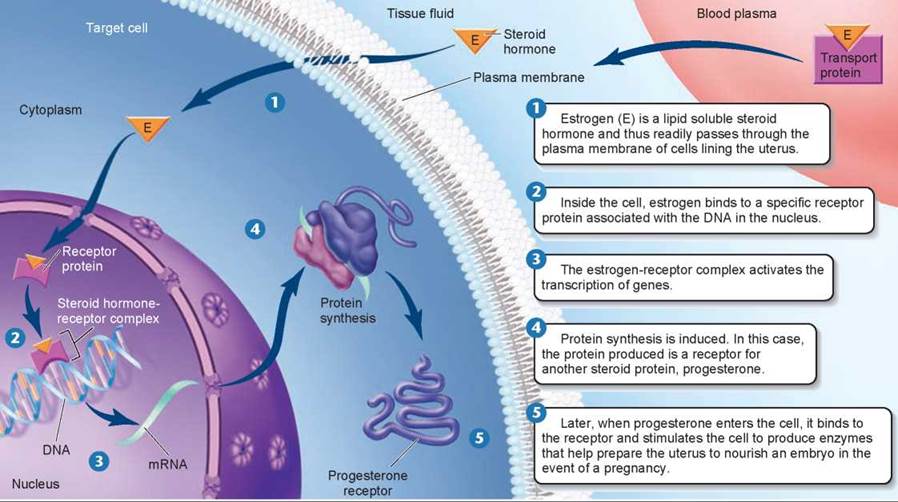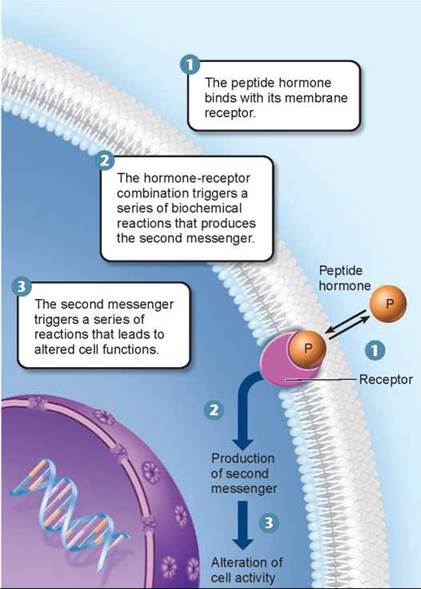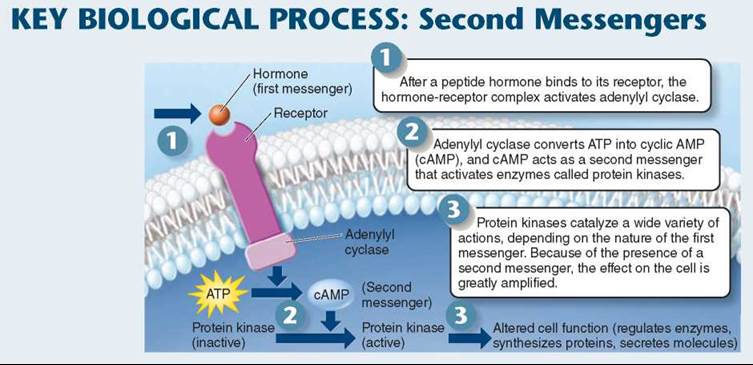THE LIVING WORLD
Unit Six. Animal Life
30. Chemical Signaling Within the Animal Body
30.2. How Hormones Target Cells
Steroid Hormones Enter Cells
Some protein receptors designed to recognize hormones are located in the cytoplasm or nucleus of the target cell. The hormones in these cases are lipid-soluble molecules, typically steroid hormones. The chemical shapes of these molecules are multi-ring structures resembling chicken wire. All steroid hormones are manufactured from cholesterol, a complex molecule composed of four rings. The hormones that promote the development of secondary sexual characteristics are steroids. They include testosterone, as well as estrogen and progesterone, which control the female reproductive system and are discussed in chapter 31. Cortisol is also a steroid hormone.
Steroid hormones, like estrogen, “E” in figure 30.2, can pass across the lipid bilayer of the cell plasma membrane 1, and bind to receptors within the cell and often, as in the case with estrogen, within the nucleus. This complex of receptor and hormone then binds to the DNA in the nucleus 2, and activates the gene for a progesterone receptor protein, which is transcribed 3. The protein is synthesized 4, and the receptor is available to bind progesterone when it enters the cell 5, which itself activates another set of genes.
Anabolic steroids, which are used by some weight lifters and other athletes, are synthetic compounds that resemble the male sex hormone testosterone. Their injection into muscles activates growth genes and causes the muscle cells to produce more protein, resulting in bigger muscles and increased strength. However, anabolic steroids have many dangerous side effects in both men and women, including liver damage, heart disease, high blood pressure, acne, balding, and psychological disorders. Men can also experience the suppression of testicular function and feminization, and women can undergo masculinization. Use in adolescents can also result in stunted growth and accelerated puberty changes. Anabolic steroids are illegal, and for many sports, athletes are tested for their presence.

Figure 30.2. How steroid hormones work.
Peptide Hormones Act at the Cell Surface
Other hormone receptors are embedded within the plasma membrane, with their recognition region directed outward from the cell surface. Peptide hormones, like the one binding to the receptor in figure 30.3 1, are typically short peptide chains (although some are full-sized proteins). The binding of the peptide hormone to the receptor triggers a change in the cytoplasmic end of the receptor protein. This change then triggers events within the cell cytoplasm, usually through intermediate within-cell signals called second messengers 2, which greatly amplify the original signal and result in changes in the cell 3.

Figure 30.3. How peptide hormones work.
How does a second messenger amplify a hormone’s signal? Second messengers activate enzymes. One of the most common second messengers, cyclic AMP (cAMP), is shown in the Key Biological Process illustration above. Cyclic AMP is made from ATP by an enzyme that removes two phosphate units, forming AMP; the ends of the AMP join, forming a circle. A single hormone molecule binding to a receptor in the plasma membrane can result in the formation of many second messengers in the cytoplasm. Each second messenger can activate many molecules of a certain enzyme, and sometimes each of these enzymes can in turn activate many other enzymes. Thus, second messengers enable each hormone molecule to have a tremendous effect inside the cell, far greater than if the hormone had simply entered the cell and sought out a single target.
Insulin is one of many hormones that acts through second messenger systems, and it provides a well-studied example of how peptide hormones achieve their effects within target cells. Most human cells have insulin receptors in their membranes—typically only a few hundred but far more in tissues involved in glucose metabolism. A single liver cell, for example, may have 100,000 of them. When insulin binds to one of these insulin receptors, the receptor protein changes its shape, prodding an adjacent signal-modulating protein on the cell interior to activate the release of Ca++ ions. The Ca++acts as a second messenger, activating a variety of cellular enzymes in a cascading series of events that greatly amplifies the strength of the original signal.

Key Learning Outcome 30.2. Steroid hormones pass through the cell's plasma membrane and bind to receptors in the cell, forming a complex that alters the transcription of specific genes. Peptide hormones do not enter cells. Instead, they bind to receptors on the target cell surface, triggering a cascade of enzymic activations within the cell.